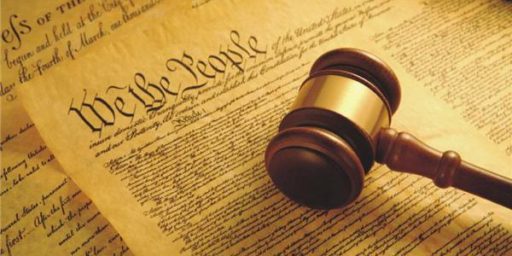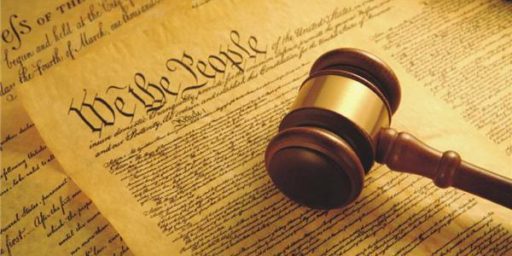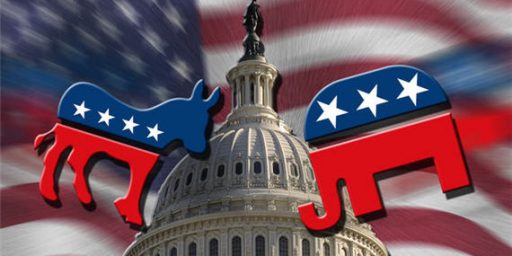Fighting Recess Appointments with Fake Sessions
Paul Bedard reports that Senate Democrats will hold bogus “sessions” in order to prevent the use of the recess appointment power.
Senate Majority Leader Harry Reid has a little trick up his sleeve that could spell an end to President Bush’s devilish recess appointments of controversial figures like former United Nations Ambassador John Bolton. We hear that over the long August vacation, when those types of summer hires are made, Reid will call the Senate into session just long enough to force the prez to send his nominees who need confirmation to the chamber. The talk is he will hold a quickie “pro forma” session every 10 days, tapping a local senator to run the hall. Senate workers and Republicans are miffed, but Reid is proving that he’s the new sheriff in town.
Steve Benen, Pamela Leavey, and Ron Beasley are pleased.
It’s far from clear, however, that this tactic will work. Article II, Section 2 states merely that, “The President shall have Power to fill up all Vacancies that may happen during the Recess of the Senate.” As FindLaw notes, “How long a ”recess’ must be to be actually a recess, a question here as in the pocket veto area, is uncertain. A ‘recess,’ however, may be merely ‘constructive,’ as when a regular session succeeds immediately upon a special session.” So, even if Bush proceeds as if these sham “sessions” constitute a session under the meaning of the Constitution, he could presumably appoint people during these interim periods, regardless of how short.
A May 2000 C-SPAN Q&A points out that all modern-day recess appointments are dubious:
The original purpose behind granting the President the power of recess appointments was to get around a practical problem. At the time the Constitution was written, short sessions and long periods of adjournment were the meeting pattern expected for Congress: the early Senate would routinely be in recess from March through December. Moreover, sessions were sometimes delayed because difficult travel conditions meant waiting a long time for enough Senators to arrive to assemble a quorum. The power given the President to make recess appointments was granted so that he wouldn’t be without top officials of government for long periods while waiting for the Senate to assemble.
Obviously, that’s no longer an issue. Recess appointments nowadays are motivated by political considerations rather than urgency. Still, that’s not exactly a new phenomenon, as T.J. Halstead notes for the Congressional Research Service:
[I]n addition to fostering administrative continuity, Presidents have exercised authority under the Recess Appointments Clause for political purposes throughout the history of the republic, giving rise to significant political and legal controversy. For instance, President Madison’s recess appointments of Albert Gallatin, John Quincy Adams and James A. Bayard as envoys to negotiate a peace treaty with Great Britain in 1813 prompted heated debate in the Senate. Presidents Jackson, Taylor, and Lincoln made hundreds of recess appointments during their terms. Additionally, recess appointments to the judiciary were common during the early years of the Republic, with the first five Presidents making 31 such appointments, including five to the Supreme Court. Among these, President Washington’s recess appointment of John Rutledge as Chief Justice generated significant controversy, ultimately factoring in his rejection by the Senate.
He goes on to note that the interpretation of the phrase “during the Recess of the Senate” has had numerous interpretations over the years, all issued by Attorneys General. The Supreme Court has largely remained on the sidelines on the issue. A 1974 D.C. Circuit case, Kennedy v. Samspon, provided some loose judicial guidelines for what constitutes a “recess” for purposes of the pocket veto. Yet,
[R]ecent Presidents have nonethelessmade numerous appointments during short intrasession recesses. President Reagan, for instance, made a number of intrasession recess appointments, one during an 18 day recess ending September 8, 1982, nine during a 23 day recess ending on July 23, 1984, and two during the 13 day recess ending on January 21, 1985. President George H.W. Bush made eight intrasession recess appointments, the shortest occurring during a 17 day recess. President Clinton made numerous intrasession appointments, including five during an 11 day recess ending on January 22, 1996, five during a 16 day recess ending on April 15, 1996, one during a nine day recess ending on June 3, 1996, and one during an 11 day recess ending on January 20, 2001. President George W. Bush has continued the recent practice of making appointments during brief intrasession recesses, including six such appointments during a recess ending on April 28, 2003, four during a 10 day recess ending on April 19, 2004, and, perhaps most controversially, the appointment of William H. Pryor to the Court of Appeals for the Eleventh Circuit on February 20, 2004, on the seventh day of a ten day recess ending on February 23, 2004.66 The Court of Appeals for the Eleventh Circuit upheld Pryor’s appointmentappointment, stating:
The Constitution, on its face, does not establish a minimum time that an authorized break in the Senate must last to give legal force to the President’s appointment power under the Recess Appointments Clause.
And we do not set that limit today.
Recess appointments, then, are one of a handful of cases where the vagueness of the Constitution creates an “invitation to struggle” on the margins of separation of powers. Republicans thought Bill Clinton was abusing the process (see, for example, this Slate piece from June 1999) and Democrats think the same of Bush. Both were probably right.
Advocates of a president, reasonably enough, think that he ought to be able to pick and choose his appointees with near-plenary power, with the Senate merely stepping in to ensure that the person has the technical and moral qualifications for the job. When the Senate, as it invariably and increasingly does, decides to bring partisan political considerations into the calculation — even to the point of using procedural holds or filibuster to preclude a vote — the president’s supporters are frustrated and urge him to use every trick in the book to get around what they see as an abuse of legislative power. Opponents of the president, naturally, see that as an abuse of executive power.
UPDATE: Steven Taylor has more background on recess appointments here and here.
There’s some back-and-forth in the comments section below about the desirability of simply ending the recess appointment power. As a practical matter, it would take a Constitutional amendment and it’s simply not going to happen; the hurdles are too high and the demand is too low.
Further, one could argue that the threat of the recess appointment gives presidents leverage to help force compromises. Absent that power, we would essentially reverse the Constitutional order of things, putting the Senate in charge of appointments with the advise of the president. Since the filibuster is now used routinely for even mildly controversial nominees, we in essence require a supermajority for the president to appoint the people he desires for policymaking jobs that are, by definition, political.






This of course can also become the new ‘practice’ when someone from the Democrat party is president.
In this day and age, when our senators from Hawaii can be in the capital in less than 24 hours, and messages can reach them in less than 24 seconds, the practice of recess appointment no longer has any practical reason to exist. It would be smarter for Reid to introduce a constitutional amendment to restrict the President’s use except in situations where a session cannot be called.
Well, I doubt that a Democratic president will have to make so many recess appointments when the Republians slip into an even smaller minority in the Senate.
I agree with Michael: the recess appointment power is an utter anachronism that ought to be abolished, although one guesses that such an amendment is unlikely.
Since recess appointment is generally, if not always, used to circumvent the power of the legislative branch, I don’t see why that branch wouldn’t propose such an amendment. Unless you mean it’s unlikely to pass, in which case I agree. Even though it’s obviously useless, there will be people who will claim that the Presidency absolutely needs that power to do it’s job.
Fake sessions? Gosh what do you think?
For one I’d point out that Bush repeatedly appoints people who lack the technical and moral qualifications for jobs.
In fact republicans are obsessed with avoiding examination of the morals involved. Do you think its appropriate that billions are being shoveled to everybody who gave Bush money? Do you think there are any quid pro quos there?
Do you think that replacing federal attorneys was about the country or about Bush and the Party? Do you think the people he chose will execute their jobs with integrity?
Let me guess. The answer to every question is always, the Dems did something as well. Sort of like comparing stealing a peck on the cheek with gang rape, but there is always some shrill cultist to proclaim they are equal.
Um, Ok. But what does that have to do with fade sessions?
putting the Senate in charge of appointments with the advise of the president
Uncharacteristically silly, JJ. The Senate does not have, and never will have, the power to nominate appointees. It can accept or reject them.
One has to believe that the Framers, who did not at all expect the Legislature and the Executive to work hand-in-hand, knew exactly what they were doing when they gave the Senate the power of “advice and consent.”
The Senate does not have, and never will have, the power to nominate appointees. It can accept or reject them.
That’s not really true anymore. In the case of district court judges, for example, homestate senators essentially appoint them with the advise and consent of the White House.
In the broader sense, though, the ability of a minority in the Senate to stop a nominee means that 60 votes are needed. That leads to compromises, where the Senate trades the president passage of some nominees in exchange for his “nominating” hand-picked candidates chosen by powerful Senators.
I thought that was a bad idea when Jesse Helms and Co. were holding Bill Clinton hostage, too, BTW.
Whatever powers these S.O.B.s take for themselves,
they should be reminded that the same powers will go to the S.O.B.s that replace them!
There is no such thing as “the Democrat Party”.
But if Rodney’s goal is to sound as small-minded and ignorant as the President, it is working…